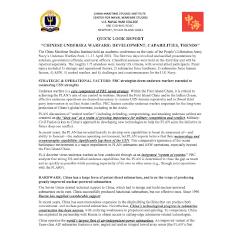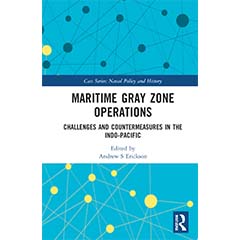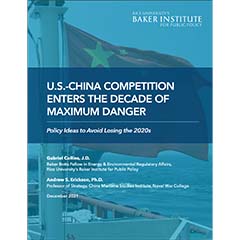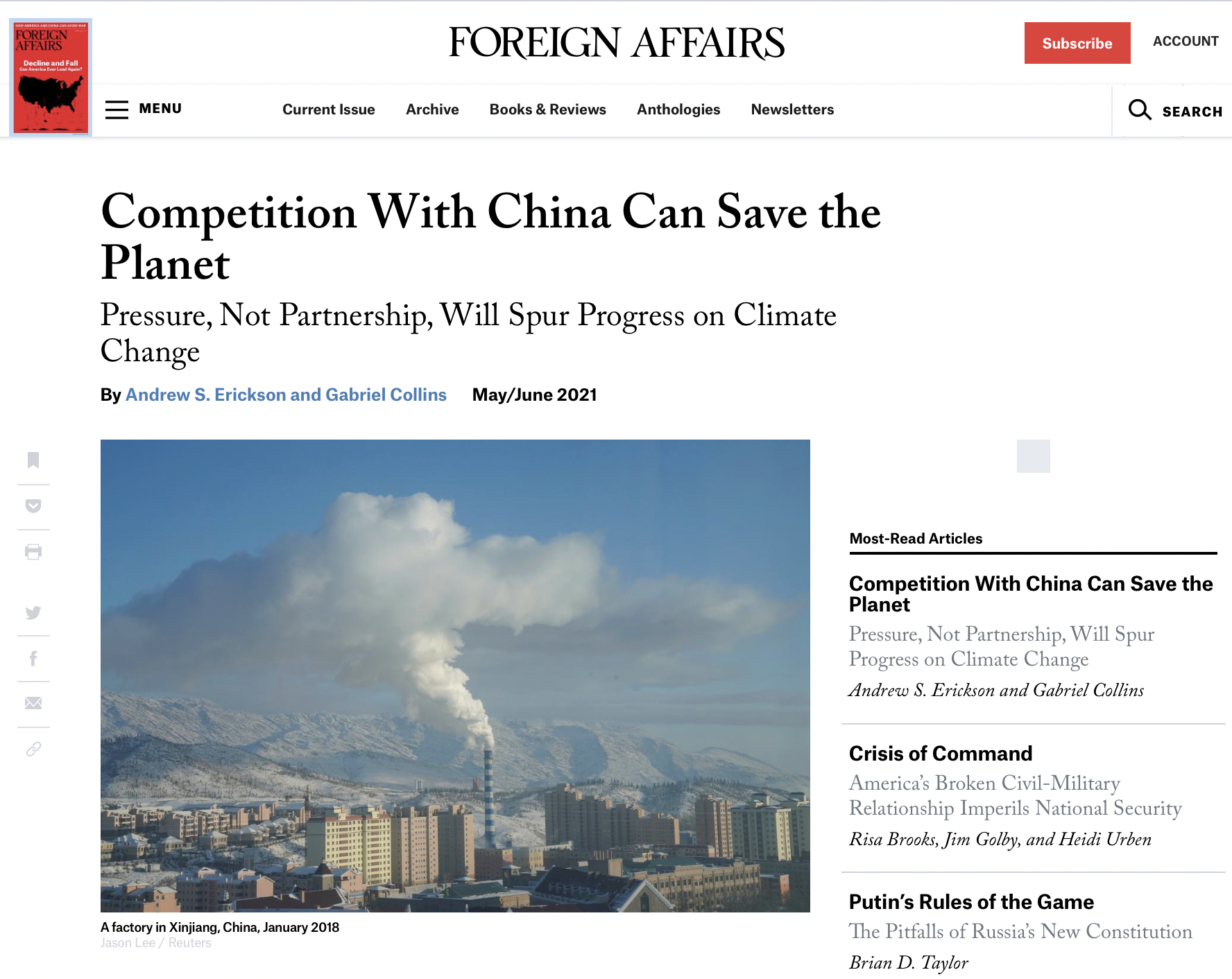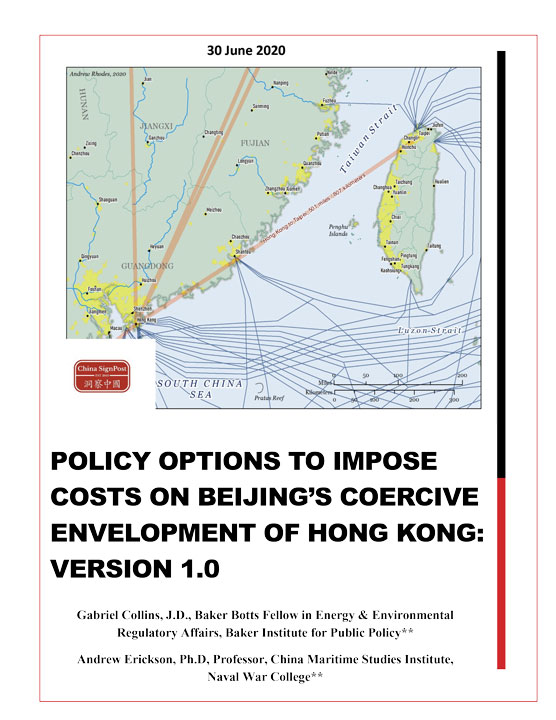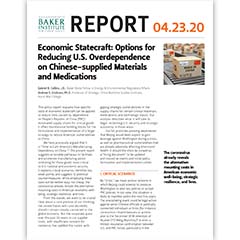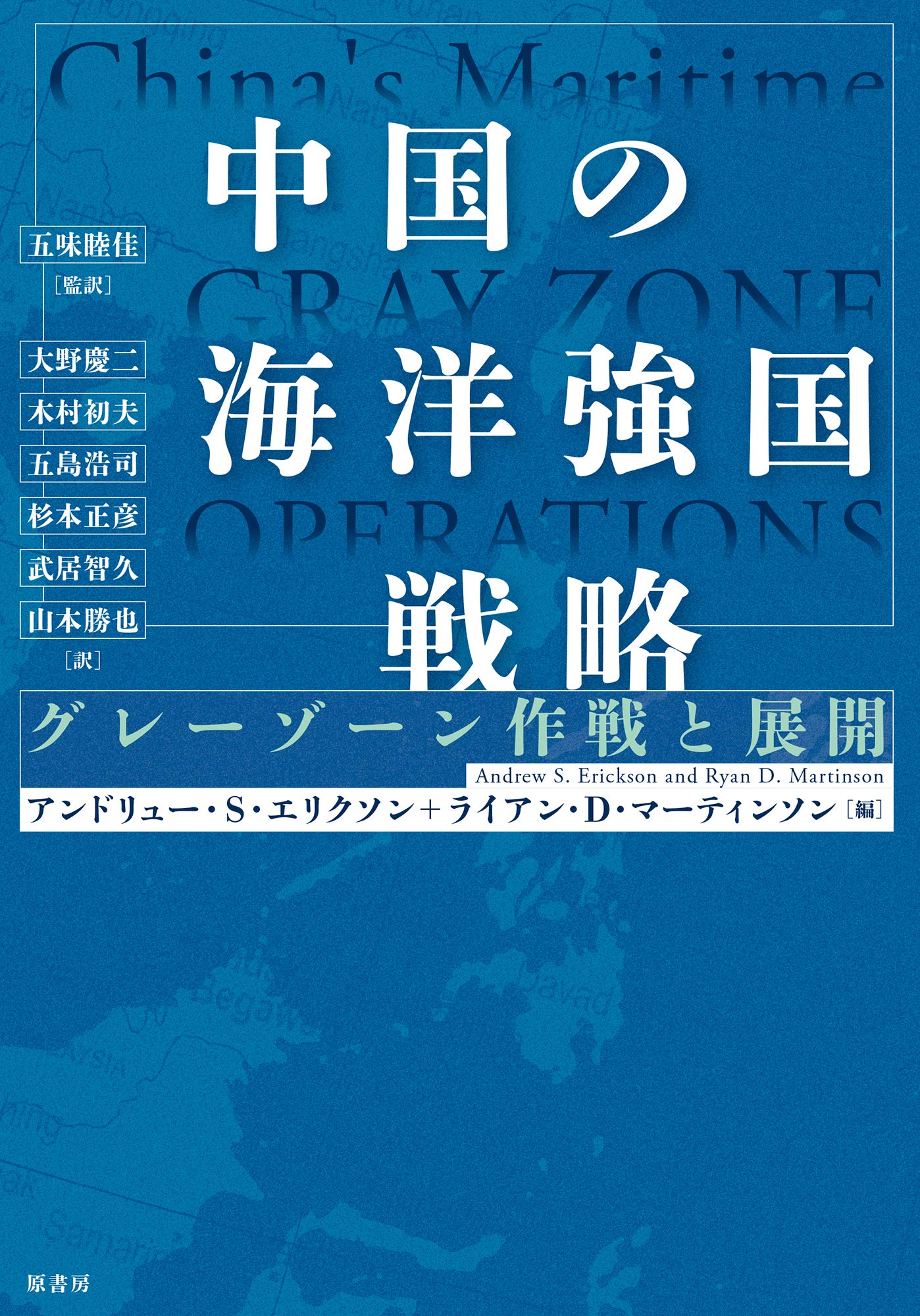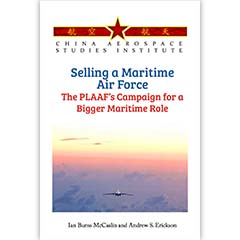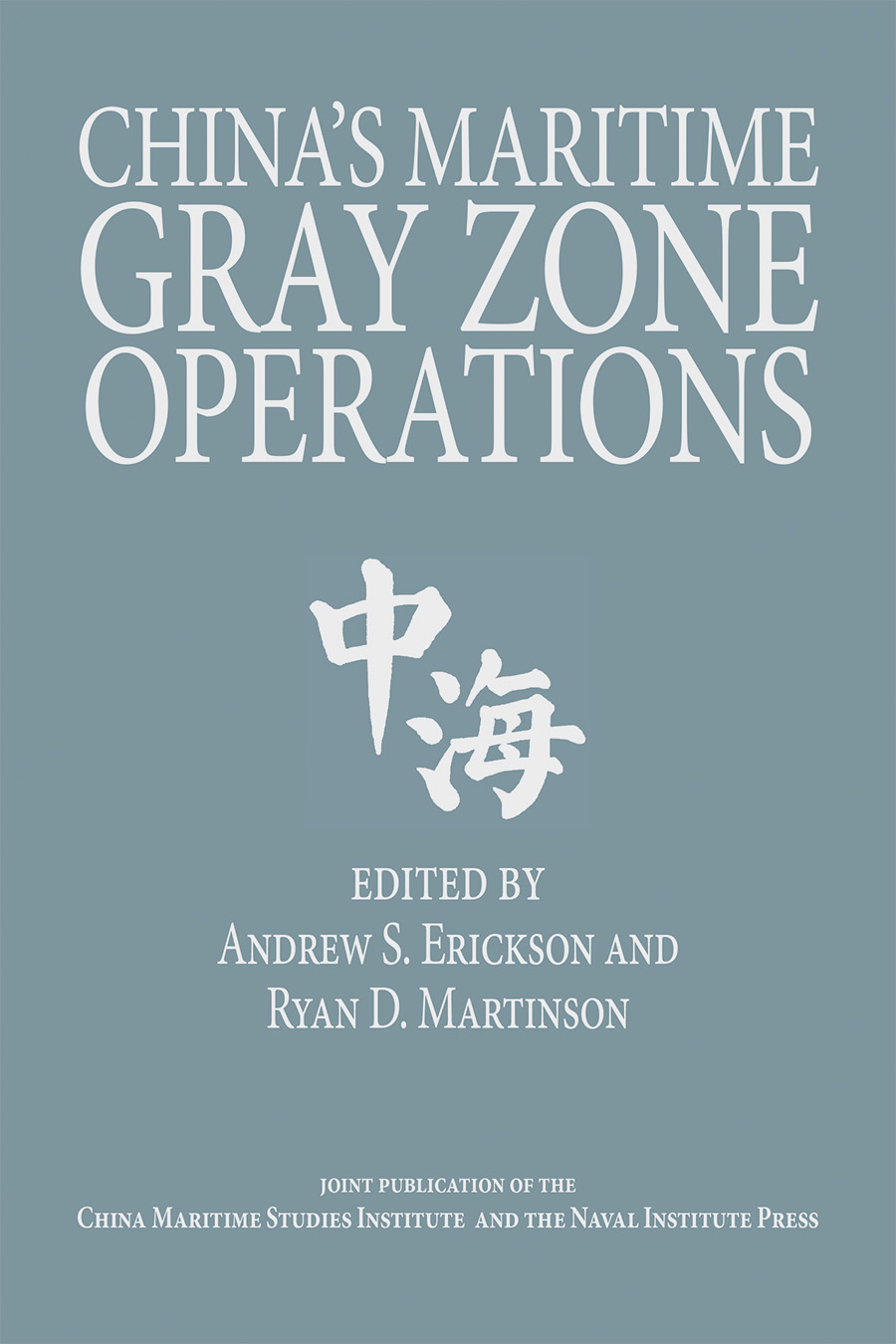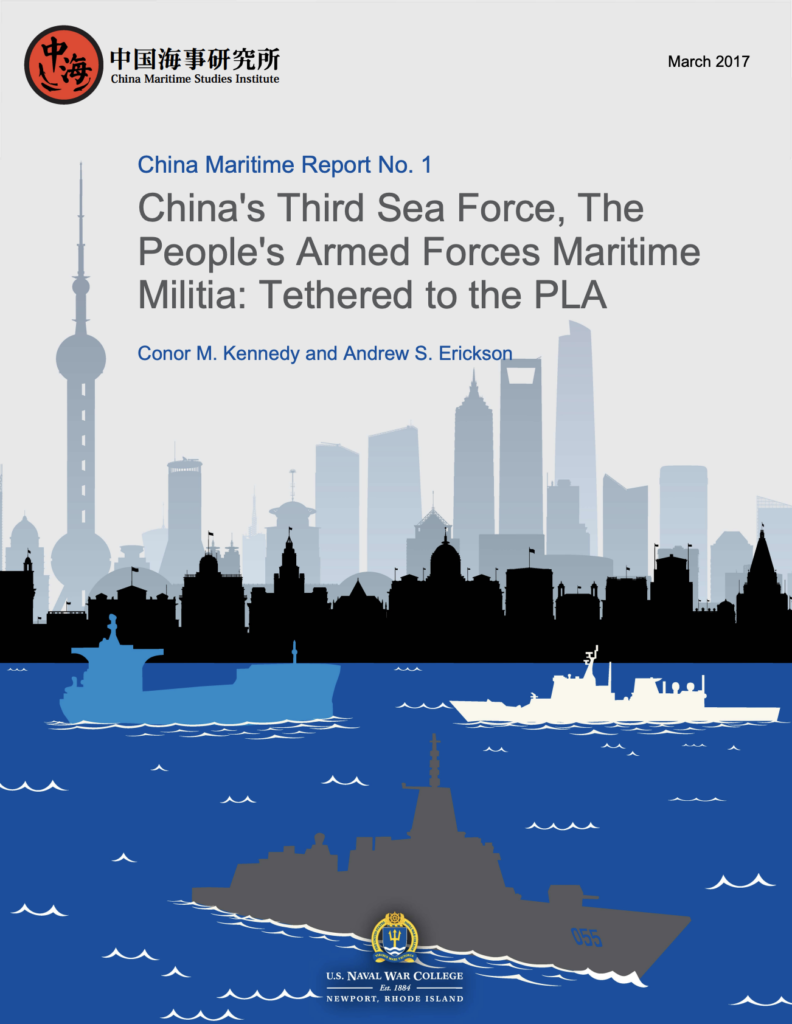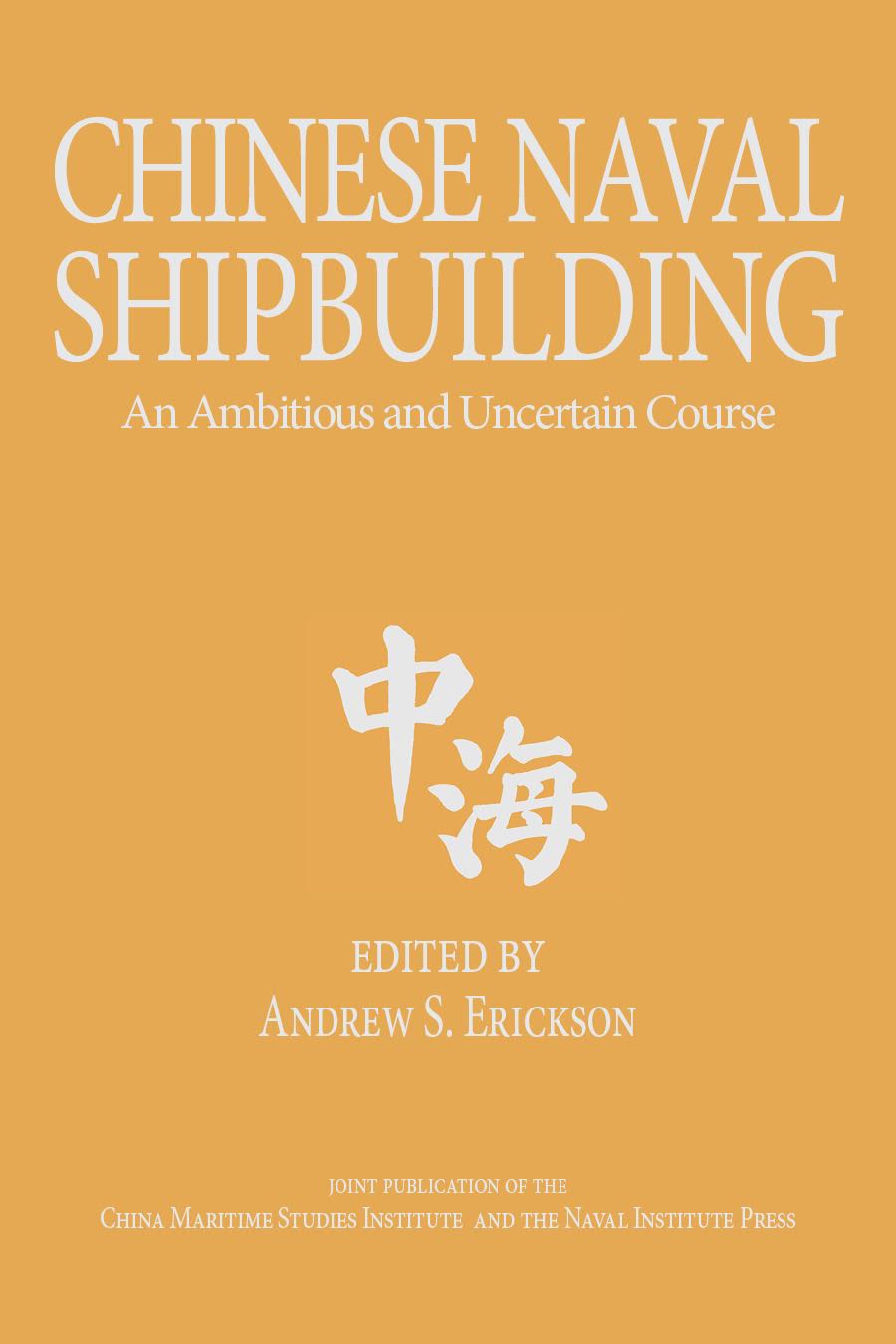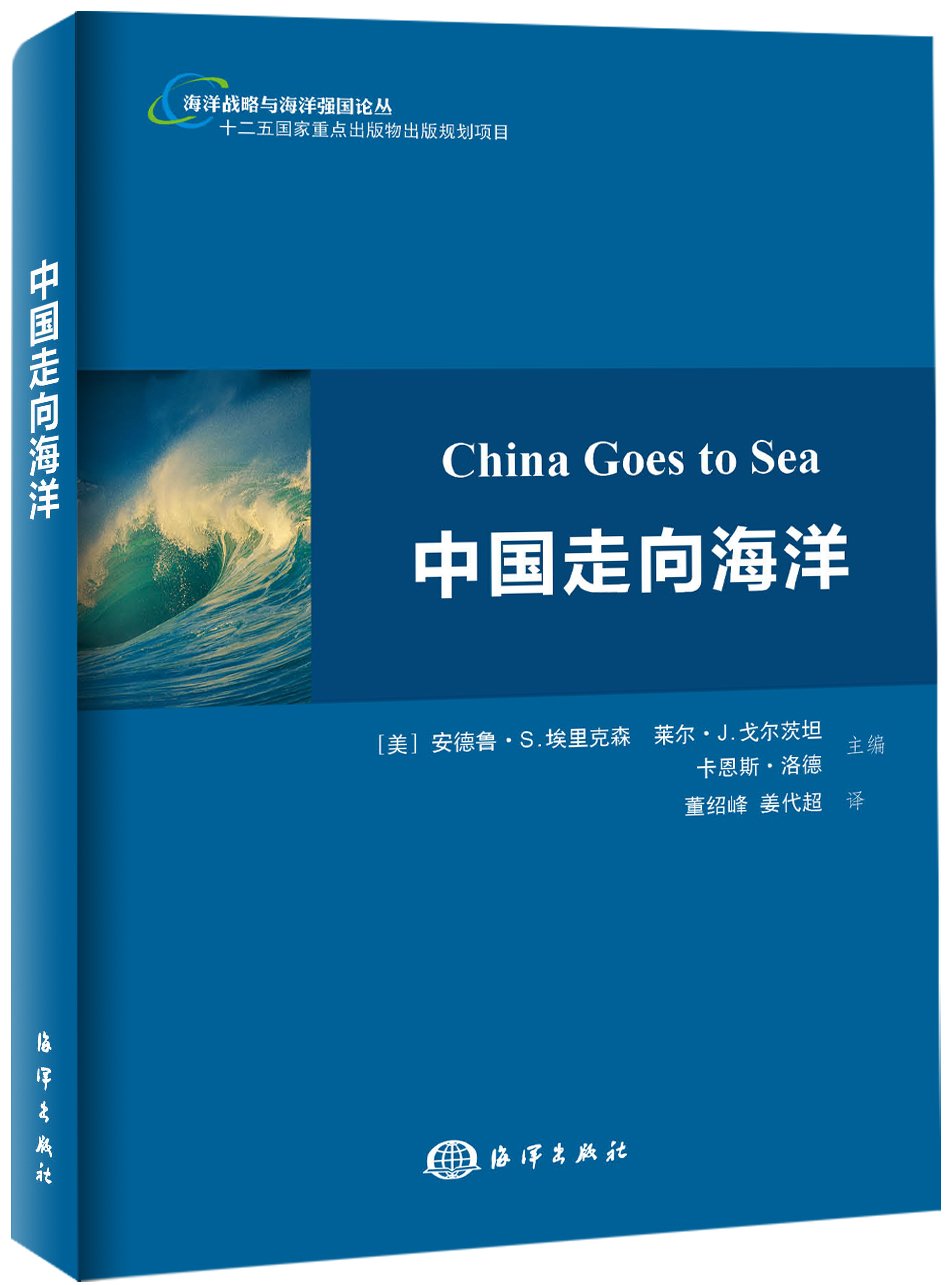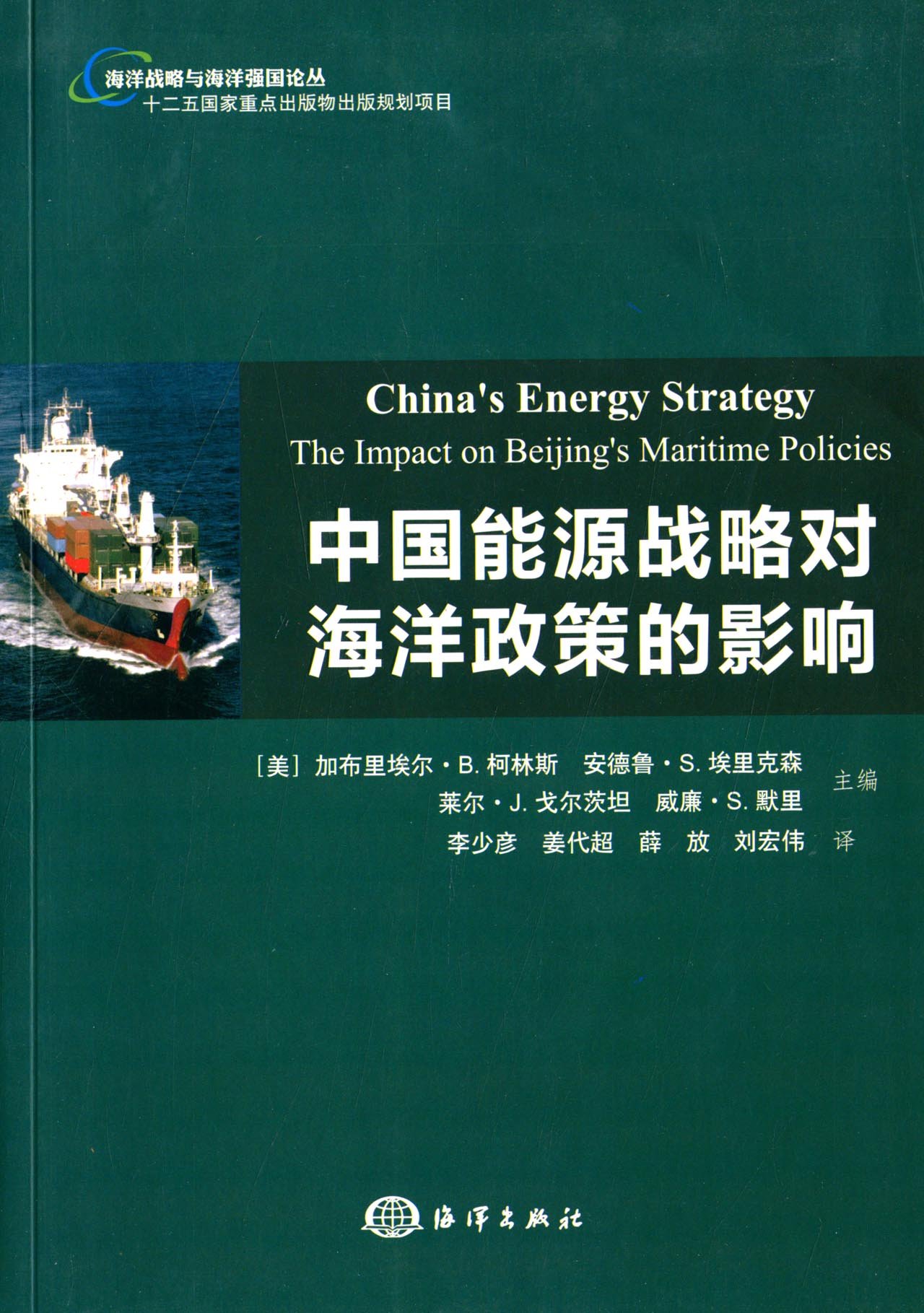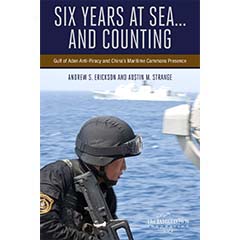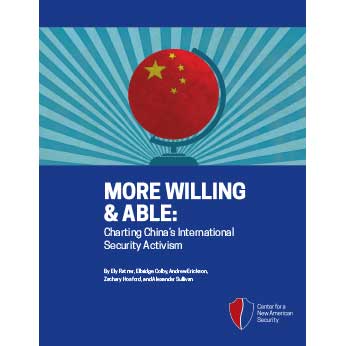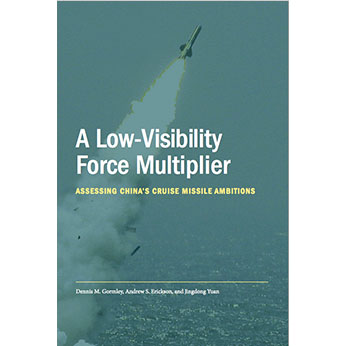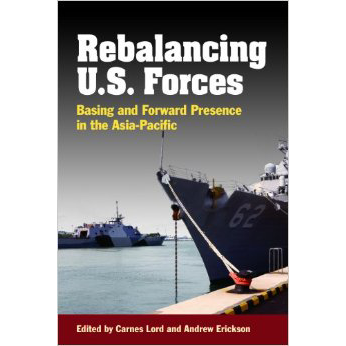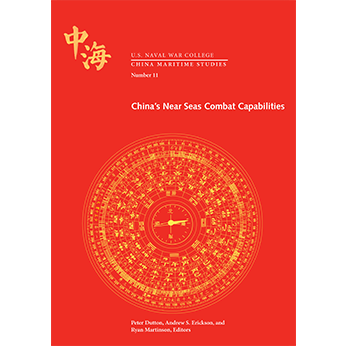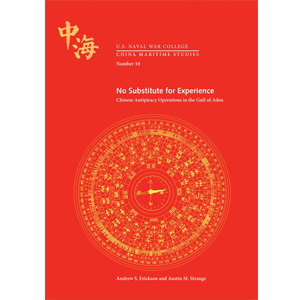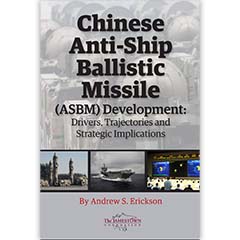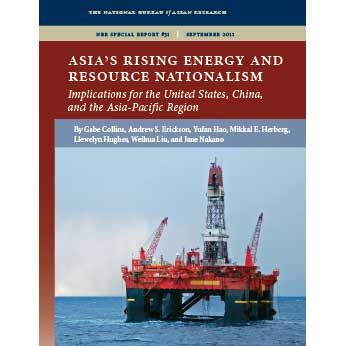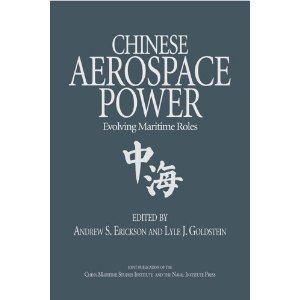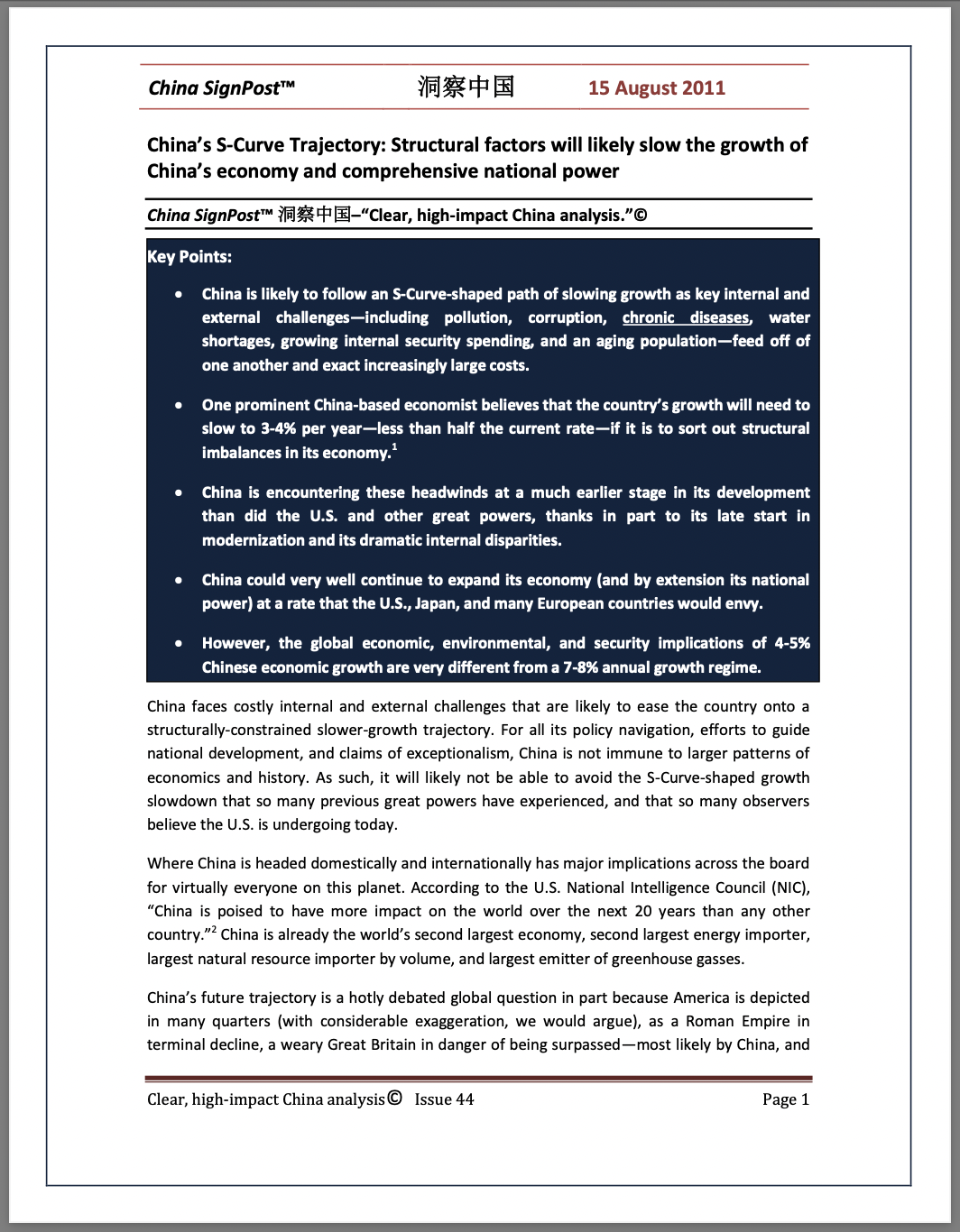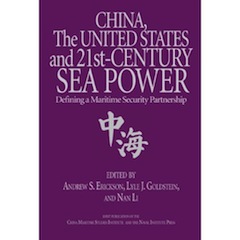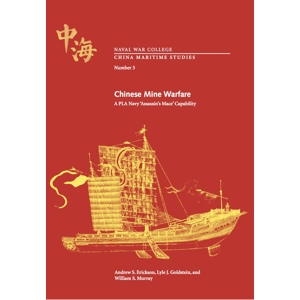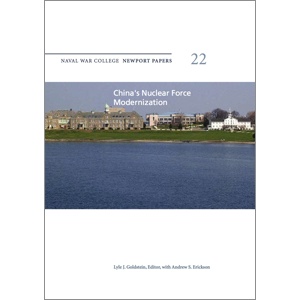China Maritime Report #47—“The People of China’s Navy & Other Maritime Forces: Extended Summary of Conference Findings”
CLICK HERE TO DOWNLOAD A CACHED PDF.
From CMSI Director Christopher Sharman:
China Maritime Watchers: Want to read the findings from the China Maritime Studies Institute (CMSI) conference, “The People of China’s Navy and Other Maritime Forces”?
Your extended summary of conference findings are here!
Expertly crafted by Dr. Andrew Erickson, these conference findings build on CMSI’s recent Quick Look Report available here.
This China Maritime Report (CMR) expands on key findings discussed in the Quick Look Report related to People’s Liberation Army Navy (PLAN) (and other maritime forces’) leadership, organization, human resources, training, naval education, as well as strengths and weaknesses.
A must read for those interested in the human factors affecting the PRC and its maritime forces!
The CMR also includes the conference agenda, photographs from the event, as well as the conference dedication to Kenneth W. Allen.
This CMR is a preview of subsequent footnoted CMSI reports that will be issued over the next several months, which will address several of the topics discussed at the conference in greater depth. An edited conference volume is also forthcoming.
Main Findings
- Xi Jinping has played a direct and active role in China’s naval buildup. He is China’s first great navalist statesman, the world’s greatest navalist leader today, and among the world’s greatest navalist statesmen in modern history.
- Notwithstanding major advances in ships, submarines, aircraft, and other hardware, Chinese military leaders believe that the People’s Liberation Army Navy (PLAN) continues to lag behind in human factors.
- Since Xi Jinping came to power in 2012, the PLAN has dismissed (or is rumored to have dismissed) eleven flag officers. Beyond combating outright dysfunction, these removals are intended to prevent potential disloyalty and factionalism, centralize power, and further modernization and warfighting goals.
- These high-profile dismissals have had no apparent impact on PLAN operational capabilities, which continue to improve at a remarkable rate. From the Taiwan Strait to the “distant oceans” (远洋), the service is present daily and visible internationally, particularly its surface fleet, indicating reliability, trust, and growing responsibilities and capabilities.
- Since 2008, the PLAN’s surface fleet has almost doubled. Despite being projected to exceed 400 ships by the end of 2025, China’s Navy continues to successfully crew, operate, and train with them.
- China’s Navy draws on a massive, sufficiently-capable talent pool and education system. Provincial-level compulsory conscription quotas avoid individual compellence thanks to high levels of volunteerism.
- Given the demands of increasingly frequent and intense training and missions—often with the austere privations of submarines or remote installations—mental health support is increasingly prioritized. Nevertheless, it remains a weakness for China’s Navy, which views U.S. care as the gold standard yet has treated counseling as a “political” issue.
- China’s Naval Command College in Nanjing—the Naval War College’s closest equivalent—educates its students differently from its counterpart in Newport by focusing on naval operations and warfighting for top-priority scenarios.
- The PLAN enjoys unique human capital advantages: educational partnerships as early as elementary school; personal data compiled centrally, available and utilizable without privacy restriction; eldercare benefits; and warfighting-focused naval education.
- PLAN sources perceive weaknesses in lack of talent for new-domain operations and advanced S&T given rising demand in these burgeoning areas; recruitment and training pipeline supply-demand imbalance and talent-skills mismatches; officers’ overly narrow early-career experience and subsequent aging out of cutting-edge relevance; and youths’ declining commitment to the Communist system.
- Despite being an improvement on its Soviet progenitor, China’s Political Commissar system could represent a critical weakness, causing real-time decision-making bottlenecks or distraction, particularly in crisis or conflict.
DISCLAIMER: This is an unclassified academic summary of findings from our most recent conference, which will subsequently be published in detail in the form of footnoted China Maritime Reports and an edited volume. Please kindly note that this distillation does not represent the views of any one individual participant, or the assessments or policies of the U.S. Navy or any other organization of the U.S. government.
U.S. Navy photo by Kristopher Burris, Naval War College, 14 May 2025 [1]
Introduction
The China Maritime Studies Institute held its biennial unclassified academic conference on 14–15 May 2025 to address human factors in the People’s Republic of China (PRC)’s military maritime forces.[2] The roughly 150 external and 200 Naval War College student and faculty attendees were mostly U.S. citizens, with several participants from allied and partner countries.[3] Panel topics included (1) the senior People’s Liberation Army Navy (PLAN) leadership, (2) the PLAN headquarters, (3) warfare communities, (4) talent recruitment, development, and retention in the PLAN, (5) the personnel of China’s other sea forces, and (6) implications for the U.S. Navy and allies/partners. With a focus on the individual personnel (officers/enlisted/civilians) of the PLAN and China’s other maritime services, their leadership, and their organizations, the conference explored several key questions: What are their strengths and weaknesses? How does their approach to education and training compare and contrast with the U.S. Navy’s? What are the likely impacts on PLAN operational capabilities?
U.S. Navy photo by Kristopher Burris, Naval War College, 14 May 2025 [4]
Leadership
Xi Jinping is China’s first great navalist statesman, the world’s greatest navalist leader today, and among the world’s greatest navalist statesmen in modern history. He considers willingness to embrace the ocean a primary determinant of a nation’s fate. He believes firmly in the importance of naval power and has pursued it concertedly and assertively as part of the most dramatic military buildup since World War II. He considers the seas surrounding China as its primary future battlefield. Xi has strongly prioritized, funded disproportionately, and grown the navy as a paramount “navy lobby of one,” since admirals are not prevalent atop the PLA leadership.[5] He has personally influenced force structure decisions, including the prioritization of nuclear-powered ballistic missile submarines (SSBNs) and aircraft carriers, as well as the expansion and upgrading in status of the PLAN Marine Corps (PLANMC). He personally decided on and promoted Beijing’s extensive feature augmentation and fortification in the South China Sea.
Building on foundational reforms by two former pioneering PLAN Commanders, Admirals Liu Huaqing (1982–88) and Wu Shengli (2006–17), China’s Navy under Xi proceeds with a sense of urgency to meet ambitious requirements through “extraordinary measures” to “overtake on the curve.” It has advanced meteorically in hardware while striving to ensure the capacity in personnel and software to employ new weapons to meet unforgiving mission requirements. Many of the greatest remaining weaknesses perceived by Xi and his military leaders lie in human factors, which have historically lagged behind the numerous, sophisticated, and, increasingly, unique weapons systems that China continues fielding with alacrity. Termed the “Two Inabilities,” “Two Big Gaps,” and “Five Incapables,” these represent concerns about the possibility of lingering limitations in command, decision-making, and related capabilities—particularly under unexpected conditions—that risk undermining the PLA’s modernization and warfighting.[6] PLAN personnel issues receive top leadership attention, with Xi setting standards at the 2022 “Central Talent Work Conference,” and the “Central Military Commission (CMC) Talent Work Conference” and “PLAN Talent Work Conference” subsequently operationalizing his guidance at the military and naval levels, respectively.
China’s Navy enjoys strong leadership, with its Commander Admiral Hu Zhongming having reportedly commanded the first Jin-class SSBN amid a stellar career in undersea, surface warfare, and management. Political Commissar Admiral Yuan Huazhi, publicly absent since 7 September 2024, has likely been removed. The PLAN functions regardless, run in large part by its Standing Committee, no member of which dominates and hence no member of which is irreplaceable. Its nearly-dozen members are particularly influential in shaping the PLAN’s development trajectory. More technically sophisticated and proficient as well as operationally and diversely experienced than their predecessors, they are better able to execute their man, train, and equip authorities,[7] despite the politically sensitive environment. Standing Committee members include the Navy’s Political Commissar, who normally serves as its Secretary; the Deputy Secretary—the serving PLAN Commander, currently Admiral Hu Zhongming; the PLAN Deputy Political Commissar; three PLAN deputy commanders, including VADM Ma Lixin; the Chief of Staff—currently VADM Li Hanjun; and the directors of the PLAN’s Political Work, Logistics, and Equipment Departments. The Secretary of the PLAN’s Discipline Inspection Commission, currently VADM Liu Xunyan, is the only addition since Xi’s 2016 reforms, indicating continuity in the PLAN’s administrative structure.
Cashiering has been a feature, not a bug, throughout Xi’s thirteen-years-and-counting rule—a constant, not a fundamental change. Since assuming power in 2012, he has removed at least 78 senior PLA officials at the Vice Admiral/Lieutenant General (2-star) level and above; 11 PLAN officers at the Rear Admiral (1-star) level or above have been, or are rumored to have been, dismissed.[8] While acknowledging that this is one of the most opaque and difficult areas to research, the panelists’ findings aligned consistently in the following direction: Removals are not intended to eradicate “corruption” by Western definition in a system lacking checks and balances with a Party inherently above the law that rewards loyalists with opportunities for graft and cronyism—which are particularly prevalent in political work, logistics, and armaments. Beyond combating outright dysfunction, removals are rather intended to prevent potential disloyalty and factionalism, centralize power, and further modernization and warfighting goals. Xi has great expectations for his military, believes corruption—as he and his Party define it—is a significant problem, and is willing to do anything to reduce it within the constraints of the existing political system.
Officers Xi has elevated earned his trust by tackling the most difficult jobs and missions and succeeding without creating problems for him. Xi weighs career achievements to judge qualifications for the highest levels; top admirals are expected to have political reliability, practical ability, social capital, and prior aptitude for navigating elite power struggles, not necessarily interactions with him over time. Distrustful and ruthless, Xi has a deep talent bench from which to draw, and is not close to running out. No longer reliant on any one group, Xi can afford to purge even his own power base, and would rather do so—however awkward—than accept risks to his authority or objectives, or the balance of power that underpins them. He appears to be trading short-term instability for longer-term commanding authority and warfighting capability. There is no major impact on immediate operational readiness since the purged have limited influence over the whole of China’s armed forces, and are readily replaceable.
Massive military exercises stress-test officers, revealing whether they are really ready to fight. Those who underperform risk failure to be promoted or even removal, perhaps actually making the PLAN stronger and more lethal in the process. The lack of high-visibility accidents over the last three years of concerted, complex Taiwan Strait exercises—with little room for error—is a remarkable achievement.[9] For China’s highest-profile interests, from the Taiwan Strait to the “distant oceans” (远洋), the PLAN is present daily and visible internationally, particularly its surface fleet; indicating reliability, trust, and growing responsibilities and capabilities.
U.S. Navy photo by Kristopher Burris, Naval War College, 14 May 2025 [10]
Organization
Rather than blindly boosting the PLAN, Xi relentlessly prioritizes warfighting through sweeping, continual military reforms. More streamlined command over the PLA subordinated the PLAN’s three fleets [now Theater Command Navies/TCNs] under three Theater Commands. Theater Commands remain PLA Army (PLAA)-dominated; Admiral Yuan Yubai has been the only PLAN officer to have commanded a TC (January 2017–June 2021), as the Southern Theater Command Commander with responsibility for the South China Sea. However, Maritime Operations Centers, which appear to be dominated by PLAN personnel, control all PLA forces operating overwater. To focus on carrier aviation, in 2023 the PLAN transferred many shore-based units to the PLA Air Force, including 300 fighter aircraft (e.g., all JH-7 maritime strike fighter-bombers) as well as all H-6J maritime strike bombers—leaving a J-11 brigade, special mission aircraft, and unmanned aerial vehicles (UAVs). Its Naval Aviation University has consolidated and refocused on educating J-15 carrier pilots recruited through multiple pipelines. The PLAA has transferred six Amphibious Brigades to the PLANMC but retains the six Amphibious Brigades most relevant to a potential cross-Strait invasion. Xi has prioritized growing the PLANMC to diversify the PLA’s cross-Strait capabilities, continue frontline support in the South China Sea, and safeguard China’s proliferating overseas interests. Now eleven brigades strong, the PLANMC has brigades in all three TCNs, elements in every theater except for the Western Theater Command, and presence at China’s first overseas military base in Djibouti.
Across a burgeoning fleet, thanks to foresighted planning, funding, and development, China’s Navy has maintained standards and readiness while increasing exercises, operational tempo, deployment frequency and duration, sophistication, and proficiency. Since 2008, the PLAN’s surface fleet has almost doubled. Despite being projected to exceed 400 ships by the end of 2025, China’s Navy continues to successfully crew, operate, and train with them. PLAN Theater-level Vessel Training Centers (VTCs) are able to ensure basic requirements and operationally certify ships. The PLAN can accommodate an expanding surface fleet because it has a large pool of qualified ship commanders. To maximize experience, Commanding Officers usually captain several ships over the course of several years, sometimes of multiple classes—in contrast to the more limited number of tours their U.S. Navy counterparts typically complete before retiring or transitioning to higher-echelon staff positions. The PLAN Headquarters’ man, train, and equip functions are vital to achieving Xi’s military modernization goals for 2027, 2035, and 2049 as well as the aim of becoming a “world-class navy” by mid-century.
The PLAN maintains a strong relationship with the China Coast Guard (CCG), Maritime Militia, and other maritime forces. It provides training support for the CCG. PLAN VTCs helped the CCG develop an Outline on Military Training and Evaluation (OMTE) and standardize cross-fleet training. Many PLAN officers have been transferred to the CCG since 2018, including the CCG’s current Commandant, Yu Zhong, and his predecessor, Wang Zhongcai.
At 12,000+ PRC-flagged vessels and two million members, China’s Merchant Marine is a strategic asset undergirding prosperity and offering strategic leverage. Its seafarers just received a 5% pay raise, and it continues to grow. Given China Ocean Shipping Company (COSCO)’s decades of supporting the PLA, it is striking how military connections and the Political Commissar system representing the Party aboard are intentionally hidden: on international routes these PRC entities disguise themselves as strictly commercial. The military-infused reality is most explicit in Roll-on/Roll-off (RO-RO) shipping, where People’s Armed Forces Department (PAFD) personnel are visible within subsidiaries.
With Xi’s strong support, the deep sea and polar domains are strategic new frontiers for China, and a potent area of Sino-Russian collaboration. Influential, strongly-funded-and-supported Chinese Academies of Sciences and Engineering Academicians and next-generation understudies pioneer their exploration and facilitate dual-use leveraging of operational and developmental Arctic and Antarctic communications facilities, space support ships, icebreakers, “Transparent Ocean” submarine detection systems, robotics, manned and unmanned submersibles, and seabed stations and laboratories. Spacecraft-inspired Deep Sea Landers offer persistent seabed presence and operations with utility for deep-sea weapons presetting at military chokepoints. Dalian Naval Academy offers a “Polar Region Navigation” course.
U.S. Navy photo by Kristopher Burris, Naval War College, 14 May 2025 [11]
Human Resources
China’s Navy draws on a massive, sufficiently-capable talent pool and education system. Provincial-level compulsory conscription quotas avoid individual compellence thanks to high levels of volunteerism. The PLAN pursues more educated populations who align with very specific requirements and recruitment slots. Recruiters mine personal data—uniquely compiled and available without restriction to PRC government and military organizations—for exquisite attributes, then target individuals through schools, advertisements, and social media networks whose algorithms are attuned to Party-State requirements. Non-Commissioned Officers (NCOs)’ competence, technical proficiency, and continuity of contributions have benefitted greatly. Significantly higher minimum standards for females yield specialized talent, including shipboard civilian linguists, medics, and engineers.
Seeking new solutions to mounting problems, China’s Navy is responding to declining demographics. Recruitment and retention are prioritized with an increasingly sophisticated, attractive salary/benefits package that even includes reproductive assistance. Unlike in the U.S. military, parents and parents-in-law of officers and NCOs can receive discounted medical care. PRC residents can only live legally and receive social welfare benefits in their place of household registration; the highest-performing rural PLAN enlistees enjoy life-altering opportunities to change their registration to attractive urban locations. PLAN veterans enjoy prioritization for government jobs far stronger than U.S. veterans’ preferences. Despite some overburdened recruiters, university indifference, and student disinterest—as well as, increasingly, American-style fitness and resilience challenges—the PLAN acquires the force it needs overall.
Given the demands of increasingly frequent and intense training and missions—often with the austere privations of submarines or remote installations—mental health support is increasingly prioritized. Nevertheless, it remains a weakness for China’s Navy, which views U.S. care as the gold standard yet has treated counseling as a “political” issue. Decentralized treatment varies greatly by unit. Outstanding performers are increasingly rewarded with convalescent rest and recreation, including at dedicated support facilities—particularly for personnel who occupy high-stress billets like submariners.
U.S. Navy Video by Petty Officer 2nd Class Connor Burns, 15 May 2025 [12]
Training
The PLAN Headquarters Staff Department is responsible for manning, training, and equipping. Its Training Bureau writes the service-wide OMTE, designing exercises based on leadership guidance. Recent trends include real confrontation exercises in complex electromagnetic environments. Dedicated blue force approaches have been complemented by “using the enemy to train the troops”—deliberately seeking and exploiting close and unsafe encounters with U.S. forces.
Weapons employment competitions exemplify increasingly realistic exercises. Randomly selected ships from across Theater Command Navies, prevented from “training to the test,” are evaluated individually. Back-to-back confrontation denies Red and Blue full opponent information. Exercises prioritize mass battle beyond formation vs. formation, with recent anti-Taiwan drills like Strait Thunder-2025A involving dozens of ships and aircraft.
Developing joint operations talent is an urgent task for the PLAN. China’s Navy is committing significant resources to advancing training technology and hybridizing its employment, much focused on the Military Training Network (MTN). MTN holds almost all PLA writings on military thought and compiles training violations. Other emphases include simulators and virtual reality, helping overcome outdated training equipment reportedly still present in academies and accommodating China’s ten-plus submarine variants. “Wavecutter” Sea-Air Integrated Campaign-Level Wargaming Simulation System scenarios include Yellow Sea Denial, Landing at Linkou (the northwestern part of New Taipei City in northern Taiwan), Decisive Fight in the Diaoyu (Senkaku) Islands, Combined Arms Airstrike against Surface Action Group(s), and “10 vs. 10 Unmanned Vehicles.” MTN and Wavecutter remain reliant on foreign open source software—with attendant security, standardization, integration, and innovation problems—because China’s Navy has not allocated the purchasing power to support a dedicated vendor ecosystem.
U.S. Navy photo by Kristopher Burris, Naval War College, 14 May 2025 [13]
Naval Education
In contrast to its American counterpart, PLAN education is service-specific, citizenship-segregated, and includes a range of specialized doctoral and post-doctoral programs. First in official protocol order (with the other PLAN education institutions covered here accordingly), the Naval Command College is the highest-level academic institution administered by China’s Navy. It educates mid-ranking commanding and staff officers from the PLAN, primarily offering a five- or ten-month command course certificate (证书) program. The College additionally enrolls a smaller number of students from other PLA services, master’s and doctoral students, and mid- and high-ranking foreign naval officers. Foreign students have separate curricula, library facilities, and electronic database access; affording PRC students, who are all military, a protected environment for maximum use of sensitive/classified information. Naval University of Engineering is one of the PLA’s five comprehensive universities. Dalian Naval Academy is focused on surface warfare. The PLAN Submarine Academy focuses primarily on training PLAN Commanding Officers and NCOs for roles related to submarining, undersea warfare, aerial anti-submarine operations, and salvage and rescue. Naval Aviation University is the PLAN’s school for pilots and other aviation personnel. Naval Medical University focuses on medical training and offers various undergraduate, graduate, and medical degrees. It accepts both civilians and pre-commissioned officers as students. The non-military students are not required to enter the military, although they may take exams to enter military employment as civilian personnel after graduation. Naval Logistics Academy is the PLAN’s main institution of education in fleet supply, support, and sustainment. Naval Petty Officer Academy is the PLAN’s main educator of NCOs. Of note, the PLAN Marine Corps Academy, which was created in 2011, was abolished in 2017 and became a training base. As such, PLAN Marine officers now receive their cadet education at the Army Special Operations Academy.
In 2019 China’s National Defense University held a seminal All-Military Group Training Conference. Its 156 attendees included service heads and military schoolhouse commandants—and Xi himself, who personally issued a broad range of directives at the institutional, staff, and academic level, subsequently codified in statute. Implementation shows PLAN education leaders self-reflectively articulating a compelling mission-centric vision; developing new procedures and capabilities as organizations of learning that themselves are learning; and welding reforms to practical warfare requirements. Deficiencies are discussed starkly, their remediation urgent: “time is running out,” “military academics must become students again,” and “we must work day and night” to “achieve a big breakthrough.” A new naval education structure is being created almost wholesale.
China’s Naval Command College in Nanjing—the Naval War College’s closest equivalent—educates its students differently from its counterpart in Newport by focusing on naval operations and warfighting for top-priority scenarios. To “educate for war,” the Naval Command College strives to better apply education to warfighting, and vice versa. It is simultaneously working to increase jointness and operational lessons and relevance, including by “sending faculty back to school” through operational secondments; making students assume other-service roles by rotating into Joint Exercise Command Post Command Billets and engaging in faculty-led site visits, simulations, and plans development, so that they better understand joint operations; lashing up with training bases and bringing outstanding senior officers (unit commanders and division- and brigade-level) and their teams to campus for intensive, protracted exchange, including detailed scenario discussion; adding new coursework in frontier technologies; and revising and replacing textbooks and curricula en masse.
To “build a Maritime War Academy,” China’s Naval Command College has “comprehensively integrated its teaching staff into the operational chain of command…with command organs at all levels.” To raise a group of talents proficient in maritime joint operations command and the employment of naval forces, it dispatches faculty teams to deeply embed in operational units’ command chains during exercises, providing commanders guidance and advice as well as post-exercise evaluations and critiques, and identifying key difficult problems requiring urgent solution; then integrating findings into their own instruction per the “study-research-train-fight teaching model.” Naval Command College faculty are integrated at all levels, including in joint command organs (i.e., Theater Commands and their components) and frontline units, where they participate in pilot projects, research, exercise planning, and operational readiness tasks. PLAN pedagogy considers wargaming one of the most important means of educating officers; the Naval Command College’s Joint Operations Education Office spearheads an increasingly wargame-focused curriculum.
While pursuing a much more specialized and applied approach, China conducts considerable research on U.S. military and naval education—not to emulate it wholesale, let alone embrace its underlying values and principles; but rather to selectively apply its rival’s strengths on its own terms. It seeks all possible insights to fill remaining gaps in jointness and other key intangibles; particularly those best practices and “tribal knowledge” that cannot be acquired through the preferred PRC means of Internet downloads or cyber hacks—and must therefore be pursued in person. PLAN academic reforms place increasing emphasis on interaction with foreign counterparts through peacekeeping, escort missions, international exercises, and military education—largely for such targeted knowledge acquisition.
China’s naval education also nurtures and seeks potential applicants from youth, fostering talent and specialization, particularly for prioritized skillsets. PLAN Aviation and Marine Corps, especially, have established pipeline partnerships with primary and secondary schools (e.g., the fourteen-campus Naval Teenagers Aviation School and PLANMC partnerships with primary schools) to a degree unseen in the United States.
U.S. Navy Video by Petty Officer 2nd Class Connor Burns, 15 May 2025 [14]
Strengths and Weaknesses
China’s military maritime forces should not be judged against an idealized U.S. model, but rather against their own assigned missions; within the context of PLA joint operations, not in isolation. For its leading scenarios, China enjoys geographic proximity; materiel, numerical, and some range-related superiority; and a preponderance of multifarious missiles, munitions, and other asymmetric capabilities that can compensate for many maritime weaknesses. Given the nature of its objectives, it enjoys strategic focus and would almost certainly have first-mover advantage, and it has been working concertedly to reduce deployment and indications and warnings timelines, which may be further blurred by increasingly large, frequent, realistic exercises.
China also enjoys unique human capital advantages: educational partnerships as early as elementary school; personal data compiled centrally, available and utilizable without privacy restriction; eldercare benefits; and warfighting-focused naval education. The PLAN’s personnel management system remains opaque, without evidence of a centralized system akin to the U.S. Bureau of Naval Personnel (BUPERS). This appears to limit standardization in personnel management. However, decentralized approaches also enable experimentation with multiple techniques simultaneously, bottom-up innovation, pragmatic adaptation, and tailored methodologies.
Official sources regard the PLAN as advantaged in ideological strength; talent pool and recruitment; size of educational and R&D systems; workforce innovation, S&T centers, and grassroots personnel; education and vocational and unit training; and relevant operational experience of younger officers with their embrace of modern doctrine and technology. PLAN sources perceive weaknesses in lack of talent for new-domain operations and advanced S&T given rising demand in these burgeoning areas; recruitment and training pipeline supply-demand imbalance and talent-skills mismatches; officers’ overly narrow early-career experience and subsequent aging out of cutting-edge relevance; and youths’ declining commitment to the Communist system—a version of intergenerational cultural clash peculiar to China’s political system. Corresponding reemphasis on political indoctrination under Xi consumes precious training time and may be quietly resented. The PLAN Headquarters Discipline Inspection Commission has likely increased professionalism, albeit at the expense of stress and distrust. The PLAN Party Committee perceives false corruption allegations impacting retention and has implemented countermeasures.
China’s Political Commissar system—while considerably more agile, sophisticated, and warfighting-oriented than its Soviet progenitor—could represent a critical weakness, causing real-time decision-making bottlenecks or distraction, particularly in crisis or conflict. The co-equal command dyad, in which Commissars head frequent consensus-based Party Committee meetings that make all major peacetime decisions within PLAN units, disempowers Commanding Officers and their operational focus. The former are said to lack understanding of equipment, the latter of personnel issues. Commissars increasingly receive military training, but their skillsets are largely interservice-fungible and they often transfer into the PLAN, particularly from the PLAA.[15] Most political officers reporting to submarines lack prior experience aboard submarines and related operational understanding. Theoretically, wartime command and control expedients could be authorized, but the entrenched system might struggle to adapt. Despite some slow-paced reform efforts, within the PLAN, personal and organizational grades still matter far more than the portable ranks defining Western militaries.[16] This makes it essential to understand how PLAN officers compare in this regard.
Other remaining weaknesses include: submarine electromechanical officers’ dead-end career tracks; failure to publicly acknowledge plane crashes and submarine accidents; and apparent deceptively-selective learning from submarine mishaps, portrayed internally through the lens of Commissars’ “heroic contributions.” Additionally, despite advancements, NCOs remain outside of command leadership forums.[17]
Looking forward, new technologies and automation may offer further workarounds and disproportionate advantages; but may struggle to adapt to fast-evolving combat conditions, especially if data become access-constrained or unreliable. A scenario of particular concern stems from the possibility that PLA/N artificial intelligence (AI)-augmented decision-making might deem certain courses of action more straightforward or promising for PRC forces than actually realistic in practice, potentially triggering unintended escalation.
Overall, China’s Navy seems to have a nuanced understanding of its strengths and weaknesses, and an institutional willingness to confront the latter. As in so many other areas, China is working relentlessly to build on its strengths, rectify its weaknesses, and mitigate challenges imposed by its all-powerful Party system. Time will tell how successful this will prove in practice, and with what impact on PLAN operational readiness and warfighting capabilities.
U.S. Navy Video by Petty Officer 2nd Class Connor Burns, 15 May 2025 [18]
Key Unresolved Questions
- Who are Xi’s intellectual influences, including the people advising him on naval issues?
- Longer-term, Xi’s removals are intended to achieve a more capable military that remains reliably under his command: How long will it take, and with what short-term impact?
- Post-2016 reforms—whereby the PLA’s eleventh force reduction cut PLAN Headquarters in half overnight and all of the second-level departments became bureaus—what precisely are the responsibilities and activities of the bureaus and offices under each of the respective PLAN Departments?
- Where do PLAN Political Officers receive their basic education?
- Will shipboard Commanding Officers begin allowing AI to make decisions about combat, and who takes responsibility if these go wrong?
- With the PLA/N having shifted to an annual two-cycle conscription system, what exercises do they still conduct during downtime periods when shy of 25% of their personnel? Could a halt on demobilization indicate preparation for major combat operations?
- Long after their national-level counterparts merged into the CCG in 2018, China Marine Surveillance and Fisheries Law Enforcement survive at the provincial level, and are involved in coercive operations around Kinmen. There is potential for incidents in these high-interest operations, so the level of professionalism of the forces involved matters greatly. Who is responsible for recruiting and training these forces? Have they returned to their pre-2018 proficiency, or fallen to a lower baseline?
U.S. Navy Video by Petty Officer 2nd Class Connor Burns, 15 May 2025 [19]
APPENDIX A: CONFERENCE AGENDA
Day One: Wednesday, 14 May 2025
09:00 Welcome Remarks and Conference Overview
09:30 Panel 1: Senior Leadership – Setting the PLAN’s Course
The opening panel focused on the key actors who lead and determine the trajectory of the PLAN, on three levels: 1) The highest commander of PLA forces, Central Military Commission (CMC) Chairman Xi Jinping; 2) other members of the CMC, and the officers assigned to its fifteen functional sections; 3) The PLAN’s Party Committee, composed of the most senior-ranking PLAN officers, including its Commander and Political Commissar.
- Presentation 1: “Xi Jinping: China’s First Navalist Leader”
- Presentation 2: “The PLAN and the Central Military Commission”
- Presentation 3: “PLAN Leadership: The PLAN Party Committee”
- Presentation 4: “Amphibious Command in a Taiwan Scenario”
11:10 Expert Reflections – Keynote Interview: “Studying the Personnel of China’s Sea Forces”
13:30 Panel 2: The PLAN Headquarters
The PLAN Headquarters and its functional departments are responsible for formulating and implementing human capital policy for the entire service. This panel examined how different departments fulfill these missions.
- Presentation 1: “PLAN Headquarters – Staff Department”
- Presentation 2: “PLAN Headquarters – Political Work Department”
- Presentation 3: “PLAN Headquarters – Logistics Department”
- Presentation 4: “PLAN Headquarters – Discipline Inspection Commission”
15:15 Panel 3: Warfare Communities
This panel examined naval personnel development “below the neck”: the advancement of personnel in the PLAN’s service arms, including their career tracks, education and training, and effectiveness.
- Presentation 1: “Surface Warfare Community”
- Presentation 2: “Submarine Community”
- Presentation 3: “Aviation Community”
- Presentation 4: “How Marines Are Made – Personnel in the Corps”
Day 1 Wrap-Up and Closing Remarks
Evening Keynote Speech: “The Human Factor in China’s Military Maritime Challenge”
Day Two: Thursday, 15 May 2025
09:00 Welcome Back and Recap of Day One
09:15 Panel 4: Attracting, Developing, and Retaining Talent
This panel focused on key issues concerning recruiting, service, education, training, and deployment of personnel in China’s Navy.
- Presentation 1: “PLAN Recruiting and the Call of the Sea”
- Presentation 2: “The PLAN’s Schoolhouses and Brain Trust”
- Presentation 3: “Technology for Education and Training”
- Presentation 4: “Key PLAN Communities: Officers, Enlisted, and Civilians”
- Presentation 5: “Building Joint Personnel – PLAN Efforts at Cultivating Integrated Joint Operations Talent”
11:00 Panel 5: The People in the PRC’s Other Sea Forces
This panel examined institutional factors influencing the trajectory and development of other service operations and organizations.
- Presentation 1: “Army Watercraft Organization and Personnel”
- Presentation 2: “China’s Coast Guard and the Maritime Law Enforcement Profession”
- Presentation 3: “Underpinning Chinese Maritime Power – The Merchant Marine”
- Presentation 4: “The People of the PRC’s Emerging Maritime Domains: Deep Sea and Arctic Development”
13:15 Breakout Presentation: “Researching PRC Military Maritime Issues with Large Language Models”
14:15 Panel 6: Implications for the U.S. Navy and Allies/Partners
The concluding panel leveraged domestic and international expertise to evaluate desired (and undesired) qualities and attributes of the people of the PLAN.
- Presentation 1: “Human Capital Management: PLAN vs. USN”
- Presentation 2: “PLAN Perceptions of its Own Weaknesses in Attracting, Developing, and Retaining Competent Personnel”
- Presentation 3: “Professionalism vs. Loyalty to Xi – Who Gets to Rise to the Top of the PLAN?”
- Presentation 4: “Corruption and Reliability Concerns in China’s Maritime Forces”
15:45 Closing Remarks and Acknowledgements
U.S. Navy photo by Kristopher Burris, Naval War College, 14 May 2025 [20]
APPENDIX B: DEDICATION
Dedicated to the career contributions of Kenneth W. Allen to the field
The focus of this year’s China’s Maritime Studies Institute conference was on a most critical but under-studied topic: the people in China’s military maritime forces. Leadership, organization, and personnel are essential to the functioning of China’s armed forces, and hence to our understanding and assessment of them, yet represent one of the greatest intangibles and uncertainties.
This conference focused on the individual personnel of the PLA Navy and other relevant services and their roles within their respective organizations, together with related dynamics, rules, and policies. We examined recruitment, education, training, career progression, retention, and roles and responsibilities of individual members of the service(s): What are their strengths and weaknesses? How does their approach to education and training differ from the U.S. Navy? How is it similar? What are the likely impacts on PLAN performance?
CMSI was therefore particularly grateful to welcome, recognize, and showcase the insights of Mr. Kenneth W. Allen, who for more than half a century has led the study of human factors regarding China’s military. Ken has tirelessly uncovered and shared all manner of personnel and organizational details, including how each unit relates to others through the grade system, and the implications of those relationships.
Ken built his analytical skills over twenty-one years in the Air Force as a linguist and intelligence officer, including with tours in both Taiwan and China. His persistent, meticulous dedication served him well as Assistant Air Attaché in Beijing during the tumultuous 1987–89 period, during which he received the Director of Central Intelligence’s Individual Exceptional Collector of the Year Award for 1988 and the Unit Exceptional Collector of the Year Award for 1989 (Tiananmen). For these signal contributions, he was inducted into the Defense Intelligence Agency’s Defense Attaché System Hall of Fame in 1997.
For the next quarter-century, Ken brought his bore-sighted focus on China’s military organizational structure, personnel, education, training, and foreign relations to researching, publishing, and supporting key institutions dedicated to the same. From 2017–19, Ken concluded his formal leadership in the field by serving as Research Director for the U.S. Air Force’s China Aerospace Studies Institute (CASI). This greatly advanced the Department of Defense Professional Military Education system’s China centers enterprise, of which CMSI is honored to be a part.
Among Ken’s many career-long contributions, the most impressive and enduring element of all is his role as the ultimate mentor and team player. He has selflessly sought to explain why it is important to understand China’s military organization and personnel, and the implications of their evolution over time. He has generously instructed and supported all who are willing to join him in this vital but under-staffed enterprise. A true teacher and mentor at heart, Ken’s self-selected epitaph, legendary in the PLA studies field, is: “He taught them Grades and Ranks.”
In many ways, this conference represented the fulfillment of Ken’s vision and the realization of his tremendous investment in our community and our field writ large over many decades. We thus could not be more honored to have had him join us in this event, which we have gratefully dedicated to him.
U.S. Navy photo by Kristopher Burris, Naval War College, 14 May 2025 [21]
[1] Panelists discuss the senior leadership of the PLAN on the opening panel of U.S. Naval War College (NWC)’s 14th CMSI Conference, held onboard Naval Station Newport, 14–15 May 2025. Biennial CMSI conferences serve to stimulate focused research and foster dialogue among topic experts resulting in enhanced understanding and continued productive research and analysis on focus areas. Established in 1884, NWC informs today’s decision-makers and educates tomorrow’s leaders by providing educational experiences and learning opportunities that develop their ability to anticipate and prepare strategically for the future, strengthen the foundations of peace, and create a decisive warfighting advantage. See https://www.dvidshub.net/image/9038838/naval-war-college-gathers-china-experts-discuss-personnel-strengths-weaknesses-pla-navy.
[2] This was CMSI’s fourteenth conference since its first on 26–27 October 2005. For a history of CMSI, see Andrew S. Erickson, “CMSI’s 20th Anniversary! China Maritime Studies Institute Established Two Decades Ago within Naval War College,” China Analysis from Original Sources 以第一手资料研究中国, 2 October 2024, https://www.andrewerickson.com/2024/10/cmsis-20th-anniversary-china-maritime-studies-institute-established-two-decades-ago-within-naval-war-college/. Information on the nine edited “Studies in Chinese Maritime Development” conference volumes published to date is available here: https://digital-commons.usnwc.edu/cmsi-studies/. Information regarding CMSI and its other publications may be found here: https://usnwc.edu/cmsi.
[3] For official news releases, see Lt. Cmdr. Peter Pagano, USN, “Naval War College Gathers China Experts to Discuss Personnel Strengths, Weaknesses of PLA Navy,” Naval War College, 15 May 2025, https://www.dvidshub.net/news/498101/naval-war-college-gathers-china-experts-discuss-personnel-strengths-weaknesses-pla-navy; Petty Officer 2nd Class Connor Burns, “Naval War College Gathers China Experts to Discuss Personnel Strengths, Weaknesses of PLA Navy,” 15 May 2025, Naval War College, https://www.dvidshub.net/video/962679/naval-war-college-gathers-china-experts-discuss-personnel-strengths-weaknesses-pla-navy.
[4] Rear Adm. Darryl Walker, president of the Naval War College, delivers welcoming remarks. See https://www.dvidshub.net/image/9039411/naval-war-college-gathers-china-experts-discuss-personnel-strengths-weaknesses-pla-navy.
[5] In 2004, the PLAN Commander, along with the commanders of the PLA Air Force and Second Artillery Force (which became the Rocket Force in 2016), was added to the CMC as a member in 2004; but, following sweeping PLA reforms in 2016, none of them were included in 2017 at the 19th Party Congress. Following Admiral Miao Hua’s suspension and subsequent removal, of the fifteen CMC organizations, only one had a PLAN officer in charge at the time of CMSI’s conference: the Politics and Law Commission, of which Admiral Wang Renhua became the Secretary in December 2019.
[6] As Dennis Blasko describes, the “two inabilities” (两个能力不够) refers to the PLA’s self-perceived concerns about its potential inability to fight a modern war and the inability of its officers to command in modern conflict; the “two big gaps” (两个差距很大) refers to gaps “ between the PLA’s military modernization level and the requirements for national security compared to the level of the world’s advanced militaries”; and the “five incapables” (五个不会) refers to the inability of some members of the officer corps to judge situations, understand higher authorities’ intentions, make operational decisions, deploy troops, and deal with unexpected situations. See Dennis J. Blasko, “The Chinese Military Speaks to Itself, Revealing Doubts,” War on the Rocks, 18 February 2019, https://warontherocks.com/2019/02/the-chinese-military-speaks-to-itself-revealing-doubts/.
[7] As distinct from operational command, man, train, and equip authority entails responsibility for building and sustaining forces. Under its auspices, personnel are recruited, assigned, and managed to meet force requirements; individuals and units receive the necessary instruction and preparation to perform their missions; and forces are provided with the necessary weapons, platforms, technology, and logistics support.
[8] Whereas U.S. Flag and General Officers’ ranks top out at the 4-star level, China’s top out at the 3-star level.
[9] More routine issues, such as aircraft or ships being scrubbed for maintenance, may occur below our detection threshold.
[10] CMSI Director Christopher Sharman addresses conference attendees. See https://www.dvidshub.net/image/9038836/naval-war-college-gathers-china-experts-discuss-personnel-strengths-weaknesses-pla-navy.
[11] Dr. Andrew Erickson, professor of strategy in the Naval War College’s China Maritime Studies Institute, left, Mr. Kenneth W. Allen, renowned China scholar, center, and Christopher Sharman, director of CMSI, discuss the personnel of China’s sea forces during a fireside chat. See https://www.dvidshub.net/image/9038850/naval-war-college-gathers-china-experts-discuss-personnel-strengths-weaknesses-pla-navy.
[12] The CMSI Library, as seen in video by Petty Officer 2nd Class Connor Burns, available at: https://www.dvidshub.net/video/962679/naval-war-college-gathers-china-experts-discuss-personnel-strengths-weaknesses-pla-navy.
[13] Dr. Kristin Mulready-Stone, professional of national security affairs at the Naval War College, moderates the conference’s opening panel. See https://www.dvidshub.net/image/9038843/naval-war-college-gathers-china-experts-discuss-personnel-strengths-weaknesses-pla-navy.
[14] Panel 4: “Attracting, Developing, and Retaining Talent,” as seen in video by Petty Officer 2nd Class Connor Burns, available at: https://www.dvidshub.net/video/962679/naval-war-college-gathers-china-experts-discuss-personnel-strengths-weaknesses-pla-navy.
[15] Recently-removed CMC Member Admiral Miao Hua is a case-in-point. More than 24 RADM+ (1-star or higher) officers likely owe their promotion to him because he had apex responsibility for all PLA Flag and General Officer promotions as CMC Political Work Department Director; nine of his promotees have been purged or investigated.
[16] Grades consist of fifteen position-specific level designators, one of which each PLA officer and entity is assigned.
[17] This refers to the Master Chief program, which is only applied to company, battalion, regiment, and brigade levels. No Master Chiefs are part of any Party Standing Committees or Party Branches.
[18] Mr. Ken Allen offers insights and poses questions at Panel 4, chaired by Mr. Peter Mattis, President, Jamestown Foundation; as seen in video by Petty Officer 2nd Class Connor Burns, available at: https://www.dvidshub.net/video/962679/naval-war-college-gathers-china-experts-discuss-personnel-strengths-weaknesses-pla-navy.
[19] Col. Erin Richter, USMCR, addresses questions posed by Mr. Ken Allen on Panel 4; as seen in video by Petty Officer 2nd Class Connor Burns, available at: https://www.dvidshub.net/video/962679/naval-war-college-gathers-china-experts-discuss-personnel-strengths-weaknesses-pla-navy.
[20] Naval War College archivists display materials at the CMSI conference on the College’s central role in the 1958 Taiwan Strait Crisis. See https://www.dvidshub.net/image/9038859/naval-war-college-gathers-china-experts-discuss-personnel-strengths-weaknesses-pla-navy. Further background: Paul J. Smith, “A Lesson from 1958 Could Help Deter China from Taking Taiwan,” DefenseOne, 1 May 2025, https://www.defenseone.com/ideas/2025/05/lesson-1958-could-help-deter-china-taking-taiwan/404952/.
[21] Mr. Ken Allen offers expert reflections during a keynote interview at the CMSI Conference. See https://www.dvidshub.net/image/9038857/naval-war-college-gathers-china-experts-discuss-personnel-strengths-weaknesses-pla-navy.













